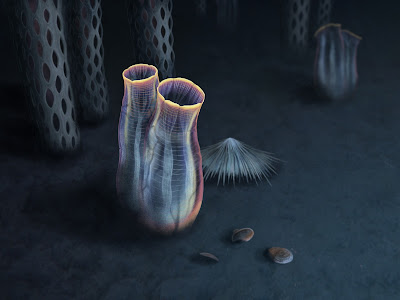 |
| Megasiphon thylakos Nanglu, Lerosey-Aubril, Weaver & Ortega-Hernández, 2023 Artwork by Franz Anthony. |
Abstract
Tunicates are an evolutionarily significant subphylum of marine chordates, with their phylogenetic position as the sister-group to Vertebrata making them key to unraveling our own deep time origin. Tunicates greatly vary with regards to morphology, ecology, and life cycle, but little is known about the early evolution of the group, e.g. whether their last common ancestor lived freely in the water column or attached to the seafloor. Additionally, tunicates have a poor fossil record, which includes only one taxon with preserved soft-tissues. Here we describe Megasiphon thylakos gen. et sp. nov., a 500-million-year-old tunicate from the Marjum Formation of Utah, which features a barrel-shaped body with two long siphons and prominent longitudinal muscles. The ascidiacean-like body of this new species suggests two alternative hypotheses for early tunicate evolution. The most likely scenario posits M. thylakos belongs to stem-group Tunicata, suggesting that a biphasic life cycle, with a planktonic larva and a sessile epibenthic adult, is ancestral for this entire subphylum. Alternatively, a position within the crown-group indicates that the divergence between appendicularians and all other tunicates occurred 50 million years earlier than currently estimated based on molecular clocks. Ultimately, M. thylakos demonstrates that fundamental components of the modern tunicate body plan were already established shortly after the Cambrian Explosion.
Systematic paleontology
Chordata (Linnaeus 1758)
Tunicata (Lamarck 1816)
Megasiphon thylakos gen. et sp. nov
Diagnosis: Barrel-shaped main body extends apically into two similarly sized, long siphons (Fig. 2a, b). Main body with millimetric circular transverse muscle bands. Siphons project at roughly a 25° angle relative to longitudinal axis of main body, and are associated with longitudinal muscle bands extending from the upper region of the main body.
Etymology: From Greek Mega (large) and siphon (siphon), referring to the prominent siphons. Species name from Greek thylakos (sac, pouch), refers to the sac-like body.
Karma Nanglu, Rudy Lerosey-Aubril, James C. Weaver and Javier Ortega-Hernández. 2023. A mid-Cambrian Tunicate and the Deep Origin of the Ascidiacean Body Plan. Nature Communications. 14, 3832. DOI: 10.1038/s41467-023-39012-4




